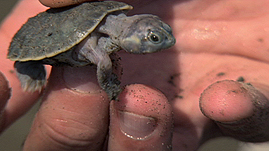Teachers' Domain - Digital Media for the Classroom and Professional Development
User: Preview


Source: Jean-Michel Cousteau: Ocean Adventures Return to the Amazon



Amazon river turtles are a vital part of the rainforest ecosystem. Although human activities are directly impacting turtle populations, climate change is also having a devastating effect on their reproductive system, creating an imbalance in the numbers of males and females. In this video segment from Jean-Michel Cousteau: Ocean Adventures, observe scientists who are studying this species and developing ways to combat the effects of climate change on their populations.
What would the world be like if one gender of the human species was extinct or did not have much time left before becoming extinct? In a less dramatic, but possibly no less drastic way, this is a plight facing many of the world’s turtle species, including river turtles like the yellow-spotted river turtle (Podocnemis unifilis) and the six-tubercled river turtle (Podocnemis sextuberculata), found in Brazil’s Mamirauá Reserve. Climate change is the likely culprit.
What does rising temperature have to do with a decline in the population of male turtles? The determination of sex in turtles is quite different than for mammals. The sex of the offspring depends on the temperature of the eggs during the first third of their incubation. This phenomenon is called temperature-dependent sex determination, or TSD.
Many turtle species already face a litany of threats: land and water pollution, loss of habitat, and consumption by humans. The impact of climate change on turtle populations is more subtle and less understood, but it is clearly having an effect: Rising temperatures lead to rising sea levels, which means more flooding and erosion at nesting sites along the shore. For some turtle species, this climatic turn could also result in fewer and fewer males.
It has been a challenge for researchers to collect information on the long-term effects of temperature on turtle populations. Good data requires that scientists be able to constantly monitor the temperatures of nests in order to determine what kinds of fluctuations lead to what kinds of effects. Since this is hard to do in the field, most studies on TSD have been in labs. And although such studies yield useful information, they can’t provide information on the larger picture of changes in a natural environment over time. What scientists do know is that turtles are ancient creatures, with fossil remains dating back 200 million years. They’ve proven resilient in the face of enormous natural challenges, surviving ice ages and the mass-extinction events that killed the dinosaurs. Perhaps they can survive the trials of a world dominated, and warmed, by humans.
 Loading Standards
Loading Standards